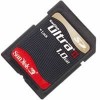SanDisk SDSDH-1024 Product Manual - Page 120
Interface
 |
UPC - 710348911073
View all SanDisk SDSDH-1024 manuals
Add to My Manuals
Save this manual to your list of manuals |
Page 120 highlights
Host Design Considerations: NAND MMC and SD-based Products Application Note Revision 1.0 The maximum read and write time-out values for the MultiMediaCard and SD Card are shown in Table 1. Table 1. MultiMediaCard and SD Card Maximum Read/Write Time-out Values Product MultiMediaCard Read Write SD Card Read Write Time-out Values Typical Maximum (TAAC + NSAC) 10 * (TAAC + NSAC) (TAAC + NSAC) * R2W_FACTOR (TAAC) + NSAC) * R2W_FACTOR * 10 (TAAC + NSAC) (TAAC + NSAC) * R2W_FACTOR 100ms 250 ms The factors used in calculating the values in Table 1-TAAC, NSAC, and R2W_FACTOR-can be read directly from the CSD register of the MultiMediaCard and SD Card. The TAAC factor's unit is time, and the NSAC factor has units of 100 clocks. You can convert TAAC units to clock cycles by multiplying by the frequency of the clock and calculate the time-outs in units of clock cycles if desired. Alternatively, given the frequency of the clock, you can convert the NSAC units to time and calculate the timeouts in units of time. The R2W_FACTOR is a read-to-write factor and has no units. A design engineer can use the time-out values derived from the CSD register to make the design compatible with all MultiMediaCards and SD cards regardless of customer brand. Interface The MultiMediaCard and SD Card support multiple busses. Both cards support the 1-bit SPI bus that includes bus pins DATin, DATout, CLK, and CS. The SPI bus is generally found on Motorola and other major MCU manufacturer products. The SD Card also supports a 4-bit and a 1-bit SD bi-directional bus mode. SD bus pins are CLK, CMD, and DAT in 1-bit mode and CLK, CMD, and DAT[0:3] in 4-bit mode. The MultiMediaCard also supports the 1-bit bi-directional MMC bus mode that has CLK, CMD, and DAT bus pins. The CMD and DAT pins are bi-directional on the SD 1-bit, SD 4-bit, and MMC 1-bit. The maximum burst rate achievable with the SD Card and MultiMediaCard depends on the clock speed and bus mode. The burst rate is the data transfer rate between the card's buffer and host. © 2002 SanDisk Corporation 4 9/30/02, Lit# 80-11-00160













